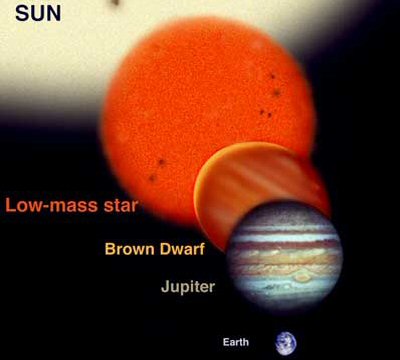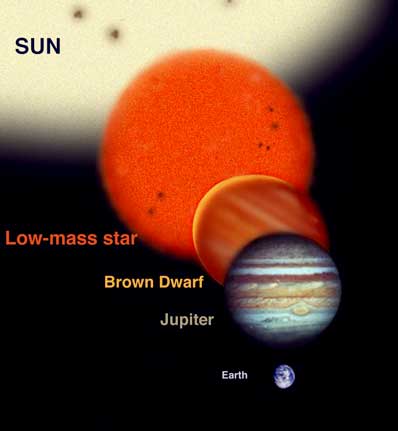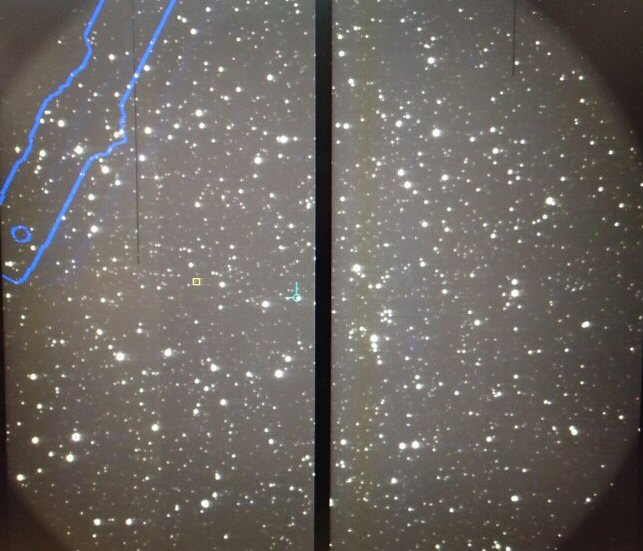
13 May Brown Dwarfs

Stars are massive bodies – the sun, which is a middle of the road dwarf star, has a mass of 2 billion billion billion tons. The crushing weight of all that material leads to enormous pressures and temperatures at the centres of stars – extreme enough to cause nuclear reactions, which again produce the radiation we see coming from these bodies.
By contrast, planets are not massive enough to ignite nuclear reactions. They shine, relatively feebly, by reflected light from the stars they orbit. The lightest stars have masses about 75 times that of the largest solar system planet Jupiter, while it is thought that the most massive planets are about 30 Jupiter masses.

See, for example, the list of more than 1800 planet discoveries to date, at explanetarchive.
What about the in-between mass regime of 30-75 Jupiter masses? It was speculated as far back as the 1960s that such objects should also exist, and the descriptive term “brown dwarfs” was coined in 1975. It was not until 1988 that the first such object was discovered.
Here are a few interesting facts about brown dwarfs:
- Brown dwarfs, by contrast with planets, generate their own radiation, by very low level nuclear reactions;
- The temperature at the centre of a brown dwarf is lower than 3 million degrees (by comparison, the core temperature of the sun is 16 million degrees);
- The surface temperatures of brown dwarfs are below 2000 degrees, and can be as low as a few hundred degrees (the surface of the sun is at 5800 degrees);
- Brown dwarfs are typically 10000 times fainter than the sun.
Given their extreme faintness, it is difficult to find brown dwarfs. Currently, after a lot of effort by many scientists, only about 1300 of these objects have been positively identified. To put this into perspective, the number of stars in modern star catalogues number in the hundreds of millions.
Finding candidate brown dwarfs is based on turning misfortune into a tool: first, because they are so cool, most of a brown dwarf’s radiation is in the form of heat, rather than optical light. If the optical light from faint heat sources in space is measured, then those objects which show almost no light are good brown dwarf candidates. The second method relies on the fact that because brown dwarfs are so faint, they can only be detected at all when they are rather close to earth – any faraway brown dwarf is simply too faint to see. This fact is combined with the observation that all the bodies in our Milky Way galaxy are in restless motion, and that this motion (termed “proper motion”) is easier to detect the closer the body is to Earth. If we therefore search for very faint objects with large proper motions, we will find nearby bodies with low brighnesses – good brown dwarf candidates.

Acquisition image taken by SALT. The UCD candidate is in the little yellow box. The blue arm is the outline of guide probe.
Confirmation that a candidate brown dwarf is the real thing requires spectroscopic classification. In a spectroscopic measurement the light from an astronomical object is passed through an instrument which spreads the light into all its constituent colours. The relative amount of light in the different colours (or wavelengths) is determined by the physical attributes of the emitting body – its temperature, chemical composition and size. Such spectroscopic “fingerprints” can therefore be used to decide the true nature of an astronomical light source. In the case of brown dwarfs the spectrum is dominated by the signatures of certain molecules and atoms which can only exist at the low temperatures of these objects.
As indicated above, brown dwarfs are very faint. Clearly then the amount of light radiated at a specific wavelength is minute, and requires a very large telescope – such as SALT – to detect and measure it. Over the course of the next few years the aim is examine dozens of new candidate brown dwarfs with SALT, and hopefully many of these will turn out to be confirmations.

